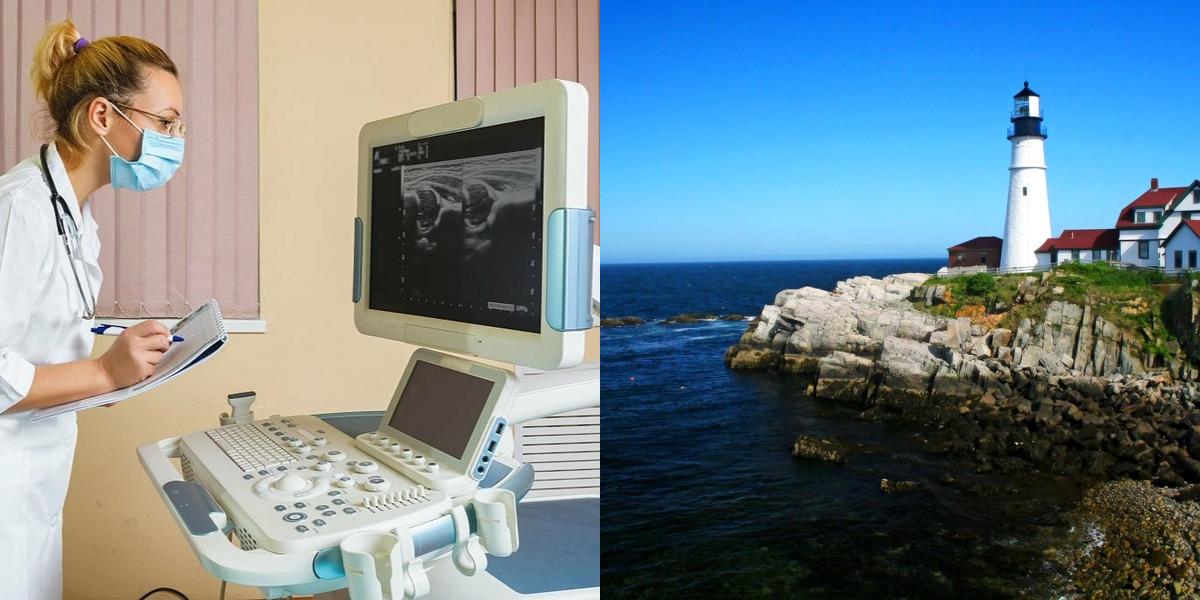How to Become a Medical Sonographer in Maine (2025)

If you're looking for a high-paying, direct path into Maine's healthcare system, becoming a Diagnostic Medical Sonographer is an excellent choice. Maine's aging population and expansive rural healthcare network drive a consistent demand for skilled imaging professionals. With a median salary of $85,070 per year, according to the U.S. Bureau of Labor Statistics, this career offers financial stability and the chance to work with cutting-edge technology. This guide provides the definitive 5-step process for navigating Maine's educational and certification requirements to launch your career in diagnostic imaging.
5. Pursue Advanced Certifications
To increase your value and salary potential, consider earning additional registries. Being "multi-modality" (e.g., certified in both Abdomen and Vascular, or Adult Echocardiography) makes you highly versatile and desirable to employers.
What are the requirements to become a Diagnostic Medical Sonographer in Maine?
To become a diagnostic medical sonographer in Maine, you must meet the following requirements:
-
Education: Complete a formal education program in diagnostic medical sonography. These programs are typically offered at community colleges, vocational schools, and universities. The program should be accredited by the Commission on Accreditation of Allied Health Education Programs (CAAHEP) or the Joint Review Committee on Education in Diagnostic Medical Sonography (JRC-DMS).
-
Certification: While certification is not required by law in Maine, most employers prefer to hire certified sonographers. The American Registry for Diagnostic Medical Sonography (ARDMS) offers a nationally recognized certification exam that you can take to become a Registered Diagnostic Medical Sonographer (RDMS).
-
Legal Requirements: In Maine, there are no specific legal requirements beyond certification for diagnostic medical sonographers. However, it is important to ensure that you adhere to the ethical and professional standards set by your employer and professional organizations.
Where can I find Diagnostic Medical Sonographer classes in Maine?
If you are interested in pursuing a career as a diagnostic medical sonographer in Maine, you can find classes on Dreambound. Dreambound is the largest platform for students to find and compare vocational training programs. They offer a wide range of resources and information to help you find the right program for your needs.
Dreambound can help you find diagnostic medical sonographer classes near you by providing a comprehensive database of accredited programs in Maine. You can search for programs based on location, accreditation, and other criteria to find the best fit for your educational goals.
To find diagnostic medical sonographer classes in Maine, feel free to explore Dreambound.
Career Paths and Opportunities after Becoming a Diagnostic Medical Sonographer
Becoming a Diagnostic Medical Sonographer opens up a variety of career paths and opportunities. Here are some of the options you can consider after obtaining your certification:
-
Hospital Settings: Many Diagnostic Medical Sonographers work in hospitals, where they perform ultrasound scans on patients. They may work in various departments, such as radiology, obstetrics and gynecology, or cardiology. In a hospital setting, you may have the opportunity to specialize in a particular area of sonography, such as vascular sonography or echocardiography.
-
Private Clinics: Another option for Diagnostic Medical Sonographers is to work in private clinics or physician's offices. In these settings, you may perform a variety of ultrasound scans, such as abdominal, pelvic, or musculoskeletal scans. Working in a private clinic can provide a more personalized and patient-focused experience.
-
Imaging Centers: Diagnostic Medical Sonographers can also work in imaging centers, which specialize in various diagnostic imaging services, including ultrasound. In an imaging center, you may have the opportunity to work with advanced imaging technologies and perform specialized ultrasound scans.
-
Research and Education: Some Diagnostic Medical Sonographers choose to pursue careers in research or education. They may work in research institutions or universities, where they contribute to the development of new imaging techniques and technologies. Others may choose to become educators, teaching future sonographers in academic or clinical settings.
-
Travel Opportunities: There are also travel opportunities available for Diagnostic Medical Sonographers. They may work as travel sonographers, providing temporary staffing in hospitals or clinics in different locations. This can be a great way to explore new places while utilizing your skills as a sonographer.
Frequently Asked Questions
Do you need a license to be a sonographer in Maine?
No, Maine does not issue a state license for sonographers. However, most employers require national certification from the ARDMS.
How much does sonography school cost in Maine?
Tuition for a 2-year associate degree at a Maine community college typically ranges from $6,000 to $10,000 for in-state residents, making it a very high-ROI education investment. Private colleges may cost significantly more.
Is sonography harder than nursing?
They are difficult in different ways. Sonography requires a deep understanding of cross-sectional anatomy and physics, and the ability to think independently to find pathology. Nursing focuses more on patient care, pharmacology, and executing treatment plans. Both are rigorous fields.
Final Thoughts
Becoming a Diagnostic Medical Sonographer is an exciting and rewarding career choice. It offers the opportunity to work in a healthcare field that is in high demand, with excellent job prospects and competitive salaries. By following the steps outlined above, you can obtain your certification and start your career as a Diagnostic Medical Sonographer.
Remember to choose an accredited program, gain clinical experience, pass the certification exam, and maintain your certification through continuing education. Once certified, you can start searching for job openings, prepare for interviews, and apply for positions that align with your interests and goals.
After obtaining your certification, you can explore various career paths, such as working in hospitals, private clinics, or imaging centers. You can also consider opportunities in research, education, or travel sonography. Whatever path you choose, it is important to continue your professional development and stay current in the field.
Overall, becoming a Diagnostic Medical Sonographer can be a fulfilling and successful career choice. Start taking the necessary steps today to pursue your dream of becoming a Diagnostic Medical Sonographer.
Are you thinking about a job change or wanting to learn more about different career paths? Feel free to check out these additional articles:

Athena is Co-founder and CEO of Dreambound.



